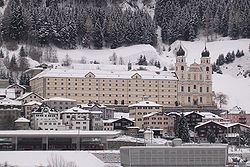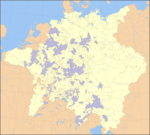- Disentis Abbey
-
Imperial Abbey of Disentis
Reichskloster Disentis (de)
Abbazia Imperiale di Disentis (it)
Claustra Imperiala da Mustér (rm)Imperial Abbey of the Holy Roman Empire 8th century–1846  →
→Coat of arms
Capital Disentis Abbey Government Theocracy Historical era Middle Ages - Founded ca 720 - Gained immediacy probably 8th century - Grey League founded 1395 - Grey League became
Swiss associate
1497- Joined Swiss Congregation 1617 - Burned and plundered
by French troops
1799- Placed under state
control by Graubünden
1846- Abbey restored 1880 Today part of  Switzerland
SwitzerlandDisentis Abbey (German: Reichskloster Disentis) is a Benedictine monastery in the Canton of Graubünden in eastern Switzerland, around which the present town of Disentis (Romansh: Mustér) grew up.
Contents
Foundation to 19th century
Formerly the date of the foundation of this abbey, attributed to the local saints Placidus and Sigisbert, was held to be 614. The tradition further states that this monastery was destroyed by the Avars in 670, when the abbot and thirty monks were martyred. The abbey, dedicated to Saint Martin, was then supposedly rebuilt by Charles Martel and Saint Pirmin in about 711.
The second and current view, based on more substantial research, is however that the foundation did not take place until the early 8th century. This is corroborated by archaeological investigation showing that the first traceable structure on the site was built in or about 700 and was destroyed in about 940, which is attributed to raiding Saracens.
The account of Sigisbert, as dramatised in the 12th century work, the "Passio Placidi", is that he was a wandering Frankish monk, inspired by the ideals of Columbanus and Luxeuil, who set up a cell here, under the protection of Saint Martin. Placidus was a local magnate and landowner, who supported Sigisbert, and who was murdered by Victor, the praeses ("president") of Chur, in an attempt to prevent the loss of independence involved in the transfer of a large amount of land to the church.
One of the earliest surviving documents relating to Disentis is the so-called "Testament of Tello", Bishop of Chur, which is dated 765 and records the already very extensive properties owned by the monastery. The story of the "Passio Placidi" makes Tello the son of Viktor, and the properties a guilt offering for the murder of Placidus. Whether or not this is so, the abbey had certainly acquired a very large estate by this date.
Charlemagne visited the re-built abbey on his return journey from Rome in 800 and made many benefactions to it. It was a "Reichskloster" (directly answerable to the Emperor and thus free from the claims of other territorial lords) from very early in its existence. Disentis' claim to imperial interest was its strategic position on a vulnerable mountain pass, and successive abbots were able to capitalise on this to the advantage of the abbey.
Udalric I (1031–55) was the first abbot to be made a prince of the empire, as were several others later; many of them also became bishops of the neighbouring sees.
In 1581 the abbey was honoured by a visit from Saint Charles Borromeo. In 1617 it became a member of the newly formed Swiss Congregation (now part of the Benedictine Confederation).
The buildings were refurbished in the Baroque style around the end of the 17th century.
In 1799 the abbey was burned and plundered by the soldiers of Napoleon's army, and many valuable items, books and archives were destroyed, including a 7th century manuscript chronicle. The printing press that had been set up in 1729 was also destroyed at the same time, but much of the melted type and other metal was saved and from it were made the pipes of the organ of the church of St. Martin's in Disentis, which is still in use. Most of what was not destroyed was confiscated to fund the war effort. The abbey also lost half of its estates. It was nevertheless rebuilt by Abbot Anselm Huonder, the last of the abbots to enjoy the rank and title of Prince of the Empire.
19th century onwards
Although Disentis managed to escape the dissolution which was the fate of most religious houses at that time, the 19th century was nevertheless a difficult and precarious period, with dangerously diminished material resources coupled with a loss of morale and spiritual discipline so severe that the abbey was not expected to survive. In desperation, Abbot Paul Birker of St. Boniface's Abbey, Munich, was sent in to attempt to turn the situation around, but with so little success that in 1861 he left Disentis and returned to Munich as a simple monk. Nevertheless, despite all the signs to the contrary, the abbey did survive. In 1880, with the restoration of religious houses in Switzerland, Disentis opened a secondary school, which continues to this day, and by the end of the 19th century had entirely regained its spiritual and material health.
The abbey continues as a religious community and as the home of a highly regarded secondary school.
Images
External links
- Official website (German)
- Disentis in German, French and Italian in the online Historical Dictionary of Switzerland.
- "Disentis Abbey". Catholic Encyclopedia. New York: Robert Appleton Company. 1913. http://www.newadvent.org/cathen/05047a.htm.
References
- Condrau, G., 1996. Disentis/Mustér: Geschichte und Gegenwart.
- Jacobsen. W., et al., 1991. Vorromische Kirchenbauten (Suppl.), pp. 93-95.
- Müller, I., 1971. Geschichte der Abtei Disentis von den Anfängen bis zur Gegenwart.
- Müller, I., 1986. Die Frühzeit des Klosters Disentis in BM, 1-45, HS III/1, pp. 474–512.
 Holy Roman Empire — Imperial abbeys of the Swabian College
Holy Roman Empire — Imperial abbeys of the Swabian CollegeImperial abbeys and colleges
(Reichsabteien, Reichsklöster
und Reichsstifte)Baindt • Comburg • Disentis • Elchingen • Frauenchiemsee • Fraumünster • Fürstenfeld • Gengenbach • Göss • Gutenzell • Heggbach • Helmarshausen • Herrenalb • Irsee • Kaisheim† • Lindau • Lorsch • Marchtal • Marmoutier • Maulbronn • Mönchrot • Mondsee • Murbach* • Neresheim • Ochsenhausen • Ottobeuren • Petershausen • Prüfening • Reichenau • Roggenburg • Rottenmünster • St. Gall's* • St. George's in Isny • Salem • Schänis • Schussenried • Schuttern • Söflingen • Ursberg • Waldsassen • Weingarten • Weissenau • WettenhausenImperial charterhouse
(Reichskartause)- Also a Prince of the Empire † Also in Rhenish College
Categories:- Imperial abbeys
- Former theocracies
- Former countries in Europe
- States of the Holy Roman Empire
- States and territories established in the 8th century
- States and territories disestablished in 1846
- Benedictine monasteries in Switzerland
- Buildings and structures in Graubünden
Wikimedia Foundation. 2010.









